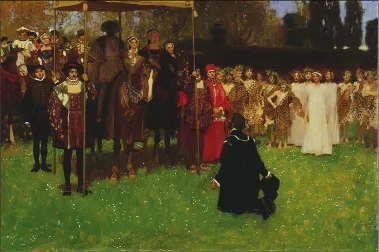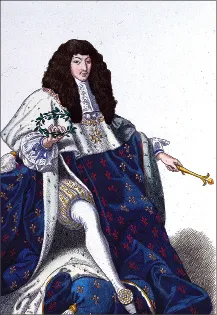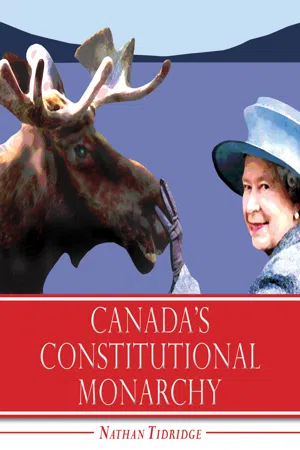Chapter One
The History of the Crown in Canada
There was a reason that the Fathers of Confederation wanted to call their new country “The Kingdom of Canada.” Even though it was the British government that ultimately vetoed the name (fearing it would upset the Americans), the Crown has been fixed within the Canadian system of government since Europeans landed on the shores of Newfoundland and Gaspé centuries ago.
“No part of this country has ever been a republic or part of a republic and to become one would be an abrupt break with our history,” wrote the late Senator Eugene Forsey. “Our monarchy, our British monarchy, our Anglo-French monarchy, our historic monarchy, is part of the Canadian tradition. It is not something alien. It is bone of our bone and flesh of our flesh.”
Sailing for the English Crown, Giovanni Caboto claimed the new lands to the west, or the “new found land,” for Henry VII in 1497. South of Newfoundland, Jacques Cartier landed in Gaspé in 1534 to declare the vast region surrounding the St. Lawrence under the authority of French King François I.
Soon after, the history of these lands became filled with stories of conflict between the English and French, as well as the First Peoples who were forced to deal with them. First Nations and early settlers (such as the Acadians) found their lands change hands from English to French, and back again, a number of times. It is this history, as well as the relationships European settlers had with the Aboriginal peoples, that has shaped how we are now governed.
Surrounded by courtiers, King François I receives Jacques Cartier and hears his stories of discoveries in the west. This painting is one of six by Frank Craig (1874–1918) produced as illustrations for The King’s Book of Québec, published in Ottawa by Mortimer Co. Limited, 1911.
Library and Archives of Canada, 1996-23-1.
Throughout this time there have been pivotal events that shaped what Canada’s government would look like, but it is important to remember that the country we now know only came together in 1867. Before Confederation, the various British and French colonies of North America saw themselves as separate and unique places, independent from each other. This early history of separation explains why today’s provinces remain so protective of their local identities and governments.
The following are some events that explain the role of the Crown in the development of Canada as a modern state.
__________
Queen Elizabeth I and Her Explorers, 1576–1603
Royal Arms of New France. The three lilies, called “French Modern” by people familiar with heraldry, represent the Roman Catholic belief in the Father, Son, and Holy Ghost. These particular arms came from Fortress of Louisburg and were saved from destruction by Governor General The Earl of Dufferin (1872–78).
CWM 19940024-001. © Canadian War Museum.
With Queen Elizabeth I waving her neckerchief from a window at Greenwich Palace, English explorer Martin Frobisher set out in 1576 on what would become a series of expeditions to the high Arctic of North America in search of a Northwest Passage to China. After returning from his first voyage with samples of ore he believed contained gold, Frobisher founded the Company of Cathay and made plans to set out the following spring with the support (both moral and financial) of his Sovereign. During his second voyage, Frobisher landed on modern-day Baffin Island, claiming it in the name of the Queen. Frobisher’s third voyage ended in financial ruin as the “gold” he mined out of the Arctic turned out to be worthless pyrite and all attempts to colonize ended in failure. Still, the explorer had sparked an interest in his Queen to establish a vast northern empire in the continent.
Elizabeth I turned to other explorers including Sir Humphrey Gilbert, who tried to establish a colony on Newfoundland in 1583, and Sir Walter Raleigh, who founded the infamous settlement at Roanoke Island (off the coast of present-day Virginia). Both schemes ended in failure, but signalled the renewed interest of the English Crown (with its financial resources) in North America, which would continue beyond the reign of the Virgin Queen.
__________
Henri IV, King of France, 1589–1610
After Cartier’s famous voyages, very little was done to promote French interests in North America until the reign of King Henri IV. Actively engaged in the settlement and development of New France, Henri IV’s vision was heavily influenced by the recent European wars of religion. The French King saw the new world as a community of Protestants and Roman Catholics loyal to the same crown and governed by a nobility based on merit and virtue. King Henri’s drive ensured the settlement of New France, capturing the imaginations of such explorers as Samuel de Champlain (who shared a similar vision for North America).
__________
Aymar de Chaste — Canada’s First Viceroy, 1602
King Henri IV appointed de Chaste, a man who shared his vision of a place of religious tolerance and harmony, as viceroy of Canada in 1602. Nearing the end of his career, de Chaste was highly respected and very well connected. It was Aymar de Chaste that Samuel de Champlain approached to become involved with the development of New France. With this meeting, author David Hackett Fischer wrote in Chaplain’s Dream:
… the elements came together. Aymar de Chaste … was a leader with a large spirit who won the respect and affection of all who knew him. Champlain was the junior partner, but with the ear of the king and his strong support. Henri IV was the royal patron who contributed his own broad vision, energy and resolve. As a group, these men framed a great enterprise that combined exploration, trade and settlement.
__________
Samuel de Champlain, (involved with Canada from 1602 to 1635)
Samuel de Champlain’s involvement with Canada began when King Henri IV accepted his request to join Aymar De Chaste’s expedition to North America. In total, Champlain travelled to New France twenty-seven times during his career, often as the representative of the French Viceroy (who, with the exception of Pierre Dugua, sieur de Mons, stayed at court in France). Champlain brought with him the vision of Henri IV and worked with the First Nations he encountered. The great settlements at Port Royal (1605, modern-day Annapolis Royal) and Quebec City (1608) were founded by the explorer as he travelled as far west as the Great Lakes. Champlain lobbied tirelessly for projects in New France, particularly after the death of King Henri IV and the accession of Louis XIII.
The rise of the powerful Cardinal Richelieu (King Louis XIII’s first minister since 1624) saw the creation in 1627 of the Hundred Associates (a.k.a the Company of New France) who held a monopoly on trade and settlement in New France. The Cardinal, as the head of this monopoly, became the ruler of New France (in the name of the King). As with previous viceroys, Richelieu deputized Champlain as his lieutenant.
Louis XIV as a young man, Edmond Lechevallier-Chevignard (1825–1902), artist.
Library and Archives of Canada, C-107650.
After briefly losing New France to the English during a war from 1628 to 1629 (which included his capture at Quebec three months after the treaty ending the conflict had been signed), Champlain was returned to the territory in 1632 as acting governor. Samuel de Champlain died in Quebec on December 25, 1635, after suffering a stroke.
Today’s governors general trace the roots of their role as the personal representative of the Sovereign in Canada all the way back to Champlain, making it the oldest Canadian public office in existence.
__________
Absolute Monarchy and the Sovereign Council, 1663
King Louis XIV (“The Sun King”) placed New France under his direct control as a Royal province (province de France) under the close watch of his minister of the marine, Jean-Baptiste Colbert. King Louis established a “Sovereign Council” to make laws and hear criminal and civil cases in New France. At the head of the table sat three people: the Governor (representative of the King), the Intendant (official responsible for justice, public order and finance), and the Bishop of Quebec.
__________
Hudson’s Bay Company, Created by Royal Charter, 1670
Following the ill-fated explorations of Henry Hudson in 1610, North America’s oldest company was created under the patronage of British King Charles II’s cousin Prince Rupert in 1670. The Royal Charter issued by the King granted the vast Hudson Bay watershed to a “… Company of Adventurers of England trading into Hudson Bay.” Nearly one-third of North America came into the possession of a company eager to feed the European hunger for fur. The Hudson’s Bay Company had a tremendous influence on British North America (including the colonies of Vancouver Island and British Columbia), and it is from its great holdings that the provinces of Manitoba, Saskatchewan, and Alberta would be carved, as well as the Yukon, Northwest Territories and, most recently, Nunavut.
North America after the Treaty of Utrecht.
Map by Pinpin.
__________
Acadians and the Treaty of Utrecht, 1713
The French distinguished the two main regions of New France as Canada (denoting the St. Lawrence Valley) and Acadia (the eastern, or maritime areas). France’s interests were largely with Canada, and so Acadia was often ignored, or used as a bargaining chip during negotiations in Europe. During the conclusion of Queen Anne’s War (a.k.a. The War of the Spanish Succession), the French Crown transferred the territory of Acadia (including its inhabitants) to the British Crown. Renamed Nova Scotia, Acadia was often looked at with suspicion by British officials, especially since the French Crown retained nearby Île Royal (Cape Breton Island) which became home to the Fortress of Louisbourg in 1720. By 1717, Acadians had declared their neutrality in the face of any renewed conflicts between the British and French. In 1730, the British Crown required Acadians to make the following oath, in exchange for religious freedom and the right to maintain their neutrality: “I sincerely promise and swear on my faith as a Christian that I will be utterly loyal, and will truly obey His Majesty King George the second, whom I recognize as the Sovereign lord of Acadia or Nova Scotia. May God so help me.”
Tensions between the British and French in Europe led to King George’s War (1744–1748), which saw the capture of the Fortress of Louisbourg by New Englanders. The 1748 peace treaty returned the fortress to the French Crown (outraging the American colonials and laying the groundwork for the 1776 revolution), causing the British to look at Nova Scotia with a new interest. Thousands of colonists (largely Protestants to counter the Acadian Roman Catholics) were brought into the colony as the capital was moved from Annapolis Royal to the newly established port of Halifax.
The arrival of Major Charles Lawrence as lieutenant governor and the outbreak of another war in 1754 led to a demand that Acadians swear an unconditional oath of allegiance to the King. Holding to their belief in neutrality, the Acadians refused, causing Lieutenant Governor Lawrence to order their deportation from all British lands. For the next seven years Acadians were forcibly removed from the region to be resettled as far away as Louisiana (the modern word Cajun is a corruption of Acadian). It is estimated that one-third of the Acadians deported during this time died from disease.
__________
The Birth of Representative Government: The Nova Scotian Assembly, 1758
Founded on Mi’kmaq land in 1749, Halifax quickly became the seat of government for the British colony of Nova Scotia (which also encompassed the modern provinces of New Brunswick and Prince Edward Island). Settlers in Halifax soon demanded an elected assembly, even travelling to London, England, to make their appeal in 1758. A letter from the British Board of Trade to the colony’s governor ordered that an elected assembly be created. Governor Lawrence got to work, and Nova Scotia’s first elected assembly (under the Crown) held elections in July 1758. This assembly was the first of its kind in what would become Canada.
__________
The French and Indian Wars (a....




